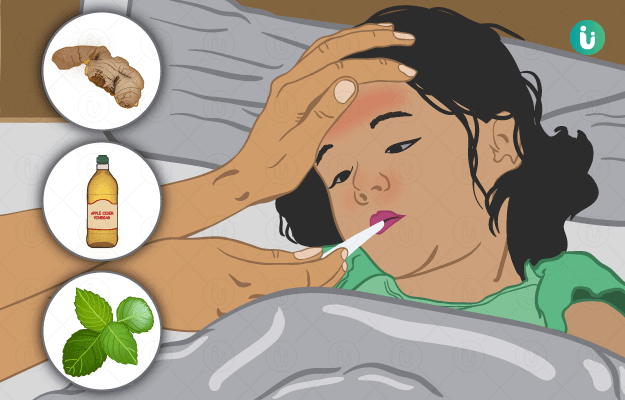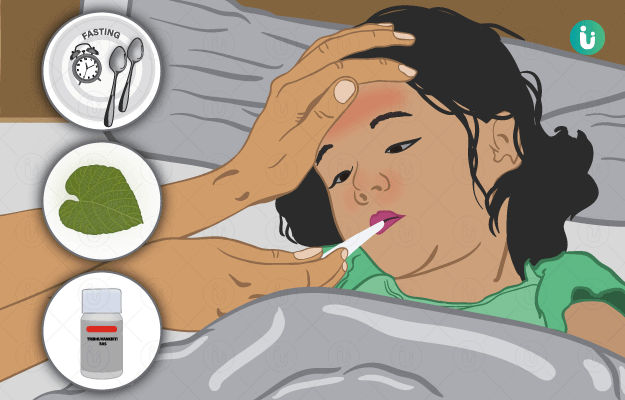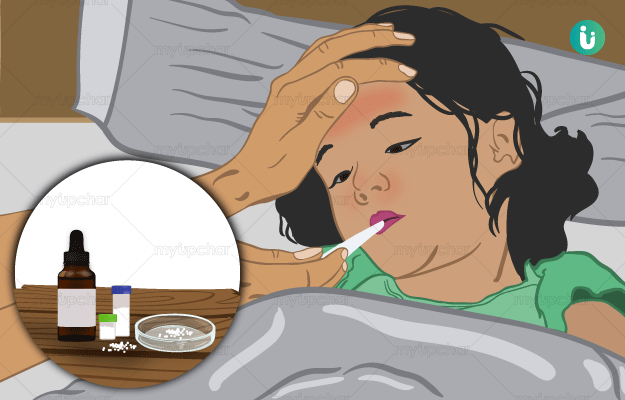Diet is the biggest matter of concern when you are running a fever. Individuals and their carers are often weighed down with the question of what to eat and what not to eat during a fever. But, do you really feel like eating when you have a fever? Well, loss of appetite is the most common symptom of fever, yet, the importance of a good diet during fever cannot be ignored. Nutritious foods not only provide you with ample amounts of energy but also help in a quicker recovery.
As much as eating the right foods is important, it is imperative that you take care of your calorie needs during a fever. Talking of right foods, it can be said that you must include a bunch of immunity-boosting foods in your diet, which will help to fight off a fever and you will rise from the bed sooner. That’s the aim, right? Also, it is a great idea to eat nourishing and hydrating foods, which will help to ease your symptoms.
Read this article to know more about all these kinds of foods. It also puts forward the foods that you must avoid during fever to keep a healthy balance.
Fever foods: what to eat
Let’s introduce you to the list of foods that you must eat during a fever, which will help lower your body temperature and make a quick recovery:
Hot soups reduce fever
Long goes the companionship of fever and warm fluids, only for the good. Soups are healthy and nutritious, as you may agree, but what exactly do they do to lower body temperature? Well, they do a lot. For the starters, soup, particularly chicken soup has been evidenced to have medicinal properties.
Studies have confirmed its anti-inflammatory properties, which means that it has the potential to reduce inflammation and heat in your body. A beneficial effect of chicken soup has also been recognised in the management of upper respiratory tract infections.
So, if you have a fever which presents with symptoms like a sore throat, cough or an irritation in the throat, having a bowl of hot soup will not only help in lowering body temperature but also ease your symptoms. What’s better? Yeah, there is more.
Soups are considered to be a whole food in themselves, providing you with a rich blend of all the essential nutrients including proteins, vitamins, minerals and calcium in a single bowl. While you run a fever, it is important to maintain a healthy and rich diet but it is most likely that your lack of appetite won’t allow that. In that case, soups can be your best friend providing you with a blend of nutrients without loading up. Further, soups can be a way of introducing other foods to your diet making the first meal. Since they are light and easy to digest, they would not pull off all your body’s energy stores in the process of digestion.
What’s more is that they help in hydrating and nourishing your body, which is very important during a fever (you’ll know ahead). With these uncountable perks, it is suggested you get your bowls ready. And don’t worry if you are a vegetarian or a vegan, while chicken soup is considered to be the best, including another source of protein in your veg soup, like cottage cheese or tofu, can also be helpful. It is the warmth and nutrition that counts.
Vitamin C rich foods to reduce fever
Fever is your body's response to fight against the disease-causing pathogen. This implies that fever is rather a helpful body mechanism than being a complete wrath. While your body is working hard to fight off those pathogens, how about the addition of foods to your diet that cater to improve your immunity and help your body win the fight? Yes, vitamin C is being hinted at, which is the best food to boost immunity.
Including a plethora of fresh fruits and vegetables like lemon, sweet lemon, potatoes, kiwi and spinach will provide you with a sufficient amount of vitamin C required for the win. You can take these in any form. Make a fruit salad, blend to form a smoothie, or mix together in a juice, all serve the purpose.
Additionally, the inclusion of vitamin C rich fruits in your diet like orange and kiwi will help to improve your palatability and enhance your taste, which is likely affected when running a fever. So, devour a bowl of freshness to bring down fever early.
Fresh fruits and vegetables to lower body temperature
Fresh fruits and vegetables are a host of several vitamins, minerals and nutrients that are required by your body in a state of fever. They not only help in providing your body with the required nutrients and energy but also helps in lowering down fever by improving your immunity. Recognising these benefits of fresh fruits and vegetables for your health, it is recommended to include at least 2 fruits and 5 vegetables in your daily diet.
Drink lots of water to bring down fever
Frequently drinking fluids has a cooling effect on your body and helps in bringing down your body temperature. When you are down with fever, it is all the more essential to be mindful of your fluid intake and what better than water. It is recommended to drink at least 8 to 10 glasses of water in a day to facilitate a reduction in body temperature.
Various studies have concluded that fluid supplementation has a highly beneficial role in keeping down the body temperature. The possible mechanism for this is that it helps to prevent dehydration and helps rehydrate the body tissues, which tend to get dehydrated due to high body temperatures. Further, drinking water also helps to ease the symptoms of fever like a sore throat or cold.
Drink hot teas to lower fever
If you are unable to keep up with your daily water intake, it is a great idea to include herbal teas in your routine. Along with hydrating you, they will help in bringing down fever. Some varieties of tea have been specifically appreciated for their antipyretic effects, especially green tea, which has been recognised to reduce the incidence of fever and illnesses by 3 times.
Herbs to lower fever
Several herbs are known for their anti-pyretic, that is, fever lowering effects. Consuming them in the right concentration helps to lower body temperature. Other than a variety of Chinese herbal formulations, easily available domestic herbs like amla and banafsa or English violet, have also been recognised for their antipyretic effects.
Other than this, there are certain herbs which have an anti-inflammatory effect, which describes another possible mechanism in which they can reduce fever. The most commonly available of these herbs is garlic, which adorns the Indian kitchens. You can include this herb within your soups and dishes to derive benefits. Amla can be eaten raw, which is also a rich source of vitamin C. For the correct dosages of these herbs, it is advisable to consult with your Ayurvedic doctor.
Eat enough food to bring down fever
Fever is marked by suppression of appetite and a person suffering from fever often eats a lot fewer than the stipulated number of calories per day. However, this should not be the case. Studies have suggested that sufficient calorie intake favours cell-mediated immunity. This is why it is important that you eat enough during a fever so that your body has enough energy to fight off the infection. Thus, make sure that you do not consume any lesser than 2,000 calories a day.
Eat properly cooked food to lower fever
While you are having a fever, it is important that you eat food that has been cooked and heated properly and is served by utmost hygiene standards. Which is why it is best to have home-cooked light meals, which are also easy to digest. It is not recommended to eat anything straight out of the refrigerator and when consuming stored food, you must take care to reheat carefully. Moreover, it is important to store your food carefully and refrigerate it within 2 hours of cooking.
Diet to bring down fever in kids and infants
An elevation in the body temperature above the normal temperature, that is, 98.6 degrees Fahrenheit, is termed as fever. While it may be caused due to a variety of factors, dehydration or lack of body fluids happens to be one of the causes.
An exploration of the cause of fever among children in a paediatric unit divulged that dehydration happens to be one of the primary causes of fever among children younger than 8 days and early identification of this cause helps to reduce an aggressive response in them. So, if your child is having a fever, it is of utmost importance that you visit a doctor at the earliest. As much as this is important, it is essential that you take care of the fluid intake of the baby. Since babies entirely rely on mother’s milk for all their fluids and nutritional needs, it is imperative that you provide them with enough feeds. Results of a research survey put forward that women tend to reduce the frequency of breastfeeding during a fever episode in infants. It is recommended to talk to your doctor if your child is not taking a proper feed and it is inadvisable to reduce the frequency of feeds at all.
Foods to avoid in a fever
Long goes the list of nutritious foods that you must eat to stay healthy during a fever, but what about the foods that you must avoid? Well, they also deserve a mention. So, here are all the foods that you must avoid during a fever:
Fast foods
Fast foods are a rich source of calories because of their preparation in trans fats but they serve no nutritional purpose. Consumption of fast foods may alter your gut microflora and lead to a severe manifestation of infections, further elevating your body temperature.
Deeply fried foods
While you run a fever, it is advisable to consume a light diet that is easier to digest. Eating deeply fried foods will add on excess calories, which will take longer to digest. This means that your body will require a greater effort for digestion of food and will be left with lesser energy stores to promote healing. So, it is better to stay away from deep fried foods.
Potato chips
Potato chips may be the most commonly consumed fried food item, so, they deserve a special mention. Munching on chips is bad for your fever symptoms as it will cause your throat to feel sore and dehydrated. Moreover, it has been ascertained that when potatoes are deeply fried, they develop compounds which may have pyretic and carcinogenic action.
Heavily non-vegetarian diet
Consuming chicken soup and broth is recommended during fever due to its nutritious contents and anti-inflammatory effects on the body. But, excessive consumption of an animal-based diet is highly inadvisable. Studies have found that a meat-based diet is commonly associated with a recurrent fever along with upper respiratory tract infection. So, if you commonly run a fever which presents with respiratory symptoms, it is best to stay away from excessive meat consumption, particularly processed and raw meats. A plant-based diet is more feasible during a fever.
Alcohol
Needless to say, it is not a great idea to consume alcohol when you are running a fever. Alcohol consumption may potentiate your symptoms and cause your body temperature to rise.
Eating at unhygienic joints
While you run a fever, it is even more essential to take care of what you eat. Eating at unhygienic restaurants and consuming street side foods introduces microorganisms to your gut, which worsens fever symptoms.
References
- Rennard BO, Ertl RF, Gossman GL, Robbins RA, Rennard SI. Chicken soup inhibits neutrophil chemotaxis in vitro. 2000 Oct;118(4):1150-7. PMID: 11035691
- Minihane AM, Vinoy S, Russell WR, Baka A, Roche HM, Tuohy KM, Teeling JL, Blaak EE, Fenech M, Vauzour D, McArdle HJ, Kremer BH, Sterkman L, Vafeiadou K, Benedetti MM, Williams CM, Calder PC. Low-grade inflammation, diet composition and health: current research evidence and its translation. 2015 Oct 14;114(7):999-1012. PMID: 26228057
- Better health channel. Department of Health and Human Services [internet]. State government of Victoria; Children's diet - fruit and vegetables
- Bazar KA, Yun AJ, Lee PY. Starve a fever and feed a cold: feeding and anorexia may be adaptive behavioral modulators of autonomic and T helper balance. 2005;64(6):1080-4.PMID: 15823688
- Richmond CA. Effects of hydration on febrile temperature patterns in rabbits. 2001 Apr;2(4):277-91. PMID: 11876467
- Wanda C. Reygaert. Green Tea Catechins: Their Use in Treating and Preventing Infectious Diseases. 2018; 2018: 9105261. PMID: 30105263
- Wu ZW, Wang ZM, Lu Y, Wang D, Qian RQ, Shang MY, Wang X, Cai SQ. Comparative study on anti-inflammatory and antipyretic effects between Dao-di herb and non Dao-di herb of Huangqin. 2012 Dec;37(23):3628-32. PMID: 23477153
- Khan MS, Hamid A, Akram M, Mustafa SB, Sami A, Shah SMA, Usmanghani K. Antipyretic potential of herbal coded formulation (Pyrexol). 2017 Jan;30(1):195-198. PMID: 28603131
- Bayan L, Koulivand PH, Gorji A. Garlic: a review of potential therapeutic effects. 2014 Jan;4(1):1-14. PMID: 25050296
- Gijs R. van den Brink, Daniëlle E. M. van den Boogaardt, Sander J. H. van Deventer, and Maikel P. Peppelenbosch. Feed a Cold, Starve a Fever?. 2002 Jan; 9(1): 182–183. PMID: 11777851
- Food safety government. Handle Leftovers with Care. U.S. Department of Health & Human Services
- Boutin A, Carceller A, Desjardins MP, Sanchez M1, Gravel J. Association Between Dehydration and Fever During the First Week of Life. 2017 Dec;56(14):1328-1335. PMID: 28198193
- Asha D Benakappa and Poojita Shivamurthy. Beliefs Regarding Diet During Childhood Illness. 2012 Jan-Mar; 37(1): 20–24.PMID: 22529535
- Ian A Myles. Fast food fever: reviewing the impacts of the Western diet on immunity. 2014; 13: 61. PMID: 24939238
- Mukund Sabnis. Viruddha Ahara: A critical view. 2012 Jul-Sep; 33(3): 332–336. PMID: 23723637
- Richard R Rosenkranz, Sara K Rosenkranz and Kelly JJ Neessen. Dietary factors associated with lifetime asthma or hayfever diagnosis in Australian middle-aged and older adults: a cross-sectional study. 2012; 11: 84. PMID: 23057785















